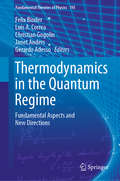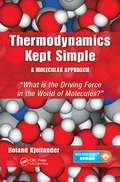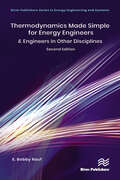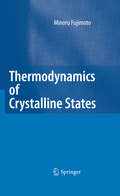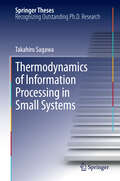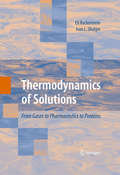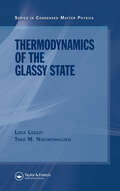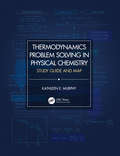- Table View
- List View
Thermodynamics in the Quantum Regime: Fundamental Aspects and New Directions (Fundamental Theories of Physics #195)
by Felix Binder Luis A. Correa Christian Gogolin Janet Anders Gerardo AdessoQuantum Thermodynamics is a novel research field which explores the emergence of thermodynamics from quantum theory and addresses thermodynamic phenomena which appear in finite-size, non-equilibrium and finite-time contexts. Blending together elements from open quantum systems, statistical mechanics, quantum many-body physics, and quantum information theory, it pinpoints thermodynamic advantages and barriers emerging from genuinely quantum properties such as quantum coherence and correlations. Owing to recent experimental efforts, the field is moving quickly towards practical applications, such as nano-scale heat devices, or thermodynamically optimised protocols for emergent quantum technologies. Starting from the basics, the present volume reviews some of the most recent developments, as well as some of the most important open problems in quantum thermodynamics. The self-contained chapters provide concise and topical introductions to researchers who are new to the field. Experts will find them useful as a reference for the current state-of-the-art. In six sections the book covers topics such as quantum heat engines and refrigerators, fluctuation theorems, the emergence of thermodynamic equilibrium, thermodynamics of strongly coupled systems, as well as various information theoretic approaches including Landauer's principle and thermal operations. It concludes with a section dedicated to recent quantum thermodynamics experiments and experimental prospects on a variety of platforms ranging from cold atoms to photonic systems, and NV centres.
Thermodynamics Kept Simple - A Molecular Approach: What is the Driving Force in the World of Molecules?
by Roland KjellanderThermodynamics Kept Simple - A Molecular Approach: What is the Driving Force in the World of Molecules? offers a truly unique way of teaching and thinking about basic thermodynamics that helps students overcome common conceptual problems. For example, the book explains the concept of entropy from the perspective of probabilities of various molecula
Thermodynamics Made Simple for Energy Engineers: & Engineers in Other Disciplines
by S. Bobby RaufEvery non-fiction book has an objective or mission. The mission of this book is to give the reader an overview of the important principles, concepts and analytical techniques pertaining to thermodynamics, written in a fashion that makes this abstract and complex subject relatively easy to comprehend. The audience this text speaks to includes engineers, professionals with science and math backgrounds, energy professionals, and technicians. The content is presented in a way which also allows many non-engineering professionals to follow the material and glean useful knowledge. For energy engineers who have been away from direct engineering practice for a while, this book will serve as a quick and effective refresher. Thermodynamics topics such as enthalpy, entropy, latent heat, sensible heat, heat of fusion, and heat of sublimation are explained and illustrated in detail. Also covered are phases of substances, the law of conservation of energy, SFEE, the first and second laws of thermodynamics, ideal gas laws, and pertinent formulas. The author examines various thermodynamic processes, as well as heat and power cycles such as Rankine and Carnot. Case studies are used to illustrate various thermodynamics principles, and each chapter concludes with a list of questions or problems for self-assessment, with answers provided at the end of the book.
Thermodynamics Of Chemical Processes
by Gareth PriceThe Primer describes the basic principles which govern reactivity and phase equilibria in chemical systems. It is written at the first year undergraduate level and contains a number of worked examples and problems to help students through this introductory material. The ideas of enthalpy,internal energy and entropy are covered to lead into Gibbs free energy and how it can be used to correlate and predict the equilibrium position and properties of chemical reactions and multi-phase systems. Some background mathematical ideas are introduced as needed as well as material describing howthe physicochemical principles can be applied to related areas such as materials science or biochemistry
Thermodynamics of Crystalline Materials: From Nano to Macro (SpringerBriefs in Materials)
by Jean-Claude TedenacThis book provides expert treatment of the use of the Calphad calculations for the study of crystal structures and thermodynamics relationships in phase diagram determination. After a short review of the relationships between crystal structures and the thermodynamics of materials, including all possible phase transformations, the book proceeds to a brief discussion of the methods for solving the stability hierarchy of different phases. Coverage includes both theoretical calculations and experimental methods based on classical thermodynamics, with emphasis on the latter. The experimental approach is mainly carried out using heat-exchange data associated with the transition of one form into another. It is demonstrated that the crystallographic properties must be associated with the phase transformations and should be taken into account. The role of X-ray crystallography therein is also discussed. Readers interested in carrying out related research will appreciate the detailed discussion and critical analysis of key results obtained by the author and his colleagues over the past five years.
Thermodynamics of Crystalline States
by Minoru FujimotoThermodynamics is an established discipline of physics for properties of matter in thermal equilibrium surroundings. Applying to crystals, however, the laws encounter undefined properties of crystal lattices, which therefore need to be determined for a legitimate description of crystalline states. Intended for readers with prior knowledge of condensed matter physics, this book emphasizes the roles played by order variables and dynamic lattices in crystals for thermodynamics of crystalline states. The crystalline state is generally heterogeneous, where order variables are in collective motion interacting with the lattice at excited levels, as witnessed in transition anomalies in dielectric crystals and from superconducting transitions in metals. The collective motion exhibits finite amplitude due to long-range order, breaking lattice symmetry that leads to a structural change. Such a non-linear process is discussed in the chapter of soliton theory, and related experimental evidences are also listed in this book. This book is divided into three parts for the convenience of readers. In Part I, basic concepts of phonons and order variables are reviewed. Part 2 is devoted to discussions of binary transitions, and in Part 3 we discuss superconducting transitions in simple metals.
Thermodynamics of Crystalline States, 2nd Edition
by Minoru FujimotoThermodynamics is a well-established discipline of physics for properties of matter in thermal equilibrium with the surroundings. Applying to crystals, however, the laws encounter undefined properties of crystal lattice, which therefore need to be determined for a clear and well-defined description of crystalline states. Thermodynamics of Crystalline States explores the roles played by order variables and dynamic lattices in crystals in a wholly new way. The book begins by clarifying basic concepts for stable crystals. Next, binary phase transitions are discussed to study collective motion of order variables, as described mostly as classical phenomena. New to this edition is the examination of magnetic crystals, where magnetic symmetry is essential for magnetic phase transitions. The multi-electron system is also discussed theoretically, as a quantum-mechanical example, for superconductivity in metallic crystals. Throughout the book, the role played by the lattice is emphasized and studied in-depth. Thermodynamics of Crystalline States is an introductory treatise and textbook on mesoscopic phenomena in solid states, constituting a basic subject in condensed matter physics. While this book serves as a guide for advanced students in physics and material science, it can also be useful as a reference for all professionals in related fields. Minoru Fujimoto is author of Physics of Classical Electromagnetism (Springer, 2007) and The Physics of Structural Phase Transitions (Springer, 2005).
Thermodynamics of Fluids Under Flow
by José Casas-Vázquez David Jou Manuel Criado-SanchoThis is the second edition of the book "Thermodynamics of Fluids under Flow," which was published in 2000 and has now been corrected, expanded and updated. This is a companion book to our other title Extended irreversible thermodynamics (D. Jou, J. Casas-Vázquez and G. Lebon, Springer, 4th edition 2010), and of the textbook Understanding non-equilibrium thermodynamics (G. Lebon, D. Jou and J. Casas-Vázquez, Springer, 2008. The present book is more specialized than its counterpart, as it focuses its attention on the non-equilibrium thermodynamics of flowing fluids, incorporating non-trivial thermodynamic contributions of the flow, going beyond local equilibrium theories, i.e., including the effects of internal variables and of external forcing due to the flow. Whereas the book's first edition was much more focused on polymer solutions, with brief glimpses into ideal and real gases, the present edition covers a much wider variety of systems, such as: diluted and concentrated polymer solutions, polymer blends, laminar and turbulent superfluids, phonon hydrodynamics and heat transport in nanosystems, nuclear collisions, far-from-equilibrium ideal gases, and molecular solutions. It also deals with a variety of situations, emphasizing the non-equilibrium flow contribution: temperature and entropy in flowing ideal gases, shear-induced effects on phase transitions in real gases and on polymer solutions, stress-induced migration and its application to flow chromatography, Taylor dispersion, anomalous diffusion in flowing systems, the influence of the flow on chemical reactions, and polymer degradation. The new edition is not only broader in scope, but more educational in character, and with more emphasis on applications, in keeping with our times. It provides many examples of how a deeper theoretical understanding may bring new and more efficient applications, forging links between theoretical progress and practical aims. This updated version expands on the trusted content of its predecessor, making it more interesting and useful for a larger audience.
Thermodynamics of Information Processing in Small Systems
by Takahiro SagawaThis thesis presents a general theory of nonequilibrium thermodynamics for information processing. Ever since Maxwell's demon was proposed in the nineteenth century, the relationship between thermodynamics and information has attracted much attention because it concerns the foundation of the second law of thermodynamics. From the modern point of view, Maxwell's demon is formulated as an information processing device that performs measurement and feedback at the level of thermal fluctuations. By unifying information theory, measurement theory, and the recently developed theory of nonequilibrium statistical mechanics, the author has constructed a theory of "information thermodynamics," in which information contents and thermodynamic variables are treated on an equal footing. In particular, the maximum work that can be extracted by the demon and the minimum work that is needed for measurement and information erasure by the demon has been determined. Additionally, generalizations of nonequilibrium relations such as a Jarzynski equality for classical stochastic systems in the presence of feedback control have been derived. One of the generalized equalities has recently been verified experimentally by using sub-micron colloidal particles. The results obtained serve as fundamental principles for information processing in small thermodynamic systems, and are applicable to nanomachines and nanodevices.
The Thermodynamics of Linear Fluids and Fluid Mixtures
by Miloslav Pekař Ivan SamohýlIn this book, Samohýl and PekaÅ(tm) offer a consistent and general non-equilibrium thermodynamic description for a model of chemically reacting mixtures. This type of model is frequently encountered in practice and up until now, chemically reacting systems (out of equilibrium) have rarely been described in books on non-equilibrium thermodynamics. Readers of this book benefit from the systematic development of the theory; this starts with general principles, going through the applications to single component fluid systems, and finishing with the theory of mixtures, including chemical reactions. The authors describe the simplest mixture model - the linear fluid - and highlight many practical and thermodynamically consistent equations for describing transport properties and reaction kinetics for this model. Further on in the book, the authors also describe more complex models. Samohýl and PekaÅ(tm) take special care to clearly explain all methodology and starting axioms and they also describe in detail applied assumptions and simplifications. This book is suitable for graduate students in chemistry, materials science and chemical engineering as well as professionals working in these and related areas.
The Thermodynamics of Linear Fluids and Fluid Mixtures
by Miloslav Pekař Ivan SamohýlIn this book, Samohýl and Pekař offer a consistent and general non-equilibrium thermodynamic description for a model of chemically reacting mixtures. This type of model is frequently encountered in practice and up until now, chemically reacting systems (out of equilibrium) have rarely been described in books on non-equilibrium thermodynamics. Readers of this book benefit from the systematic development of the theory; this starts with general principles, going through the applications to single component fluid systems, and finishing with the theory of mixtures, including chemical reactions. The authors describe the simplest mixture model – the linear fluid – and highlight many practical and thermodynamically consistent equations for describing transport properties and reaction kinetics for this model. Further on in the book, the authors also describe more complex models. Samohýl and Pekař take special care to clearly explain all methodology and starting axioms and they also describe in detail applied assumptions and simplifications. This book is suitable for graduate students in chemistry, materials science and chemical engineering as well as professionals working in these and related areas.
Thermodynamics of Magnetizing Materials and Superconductors
by Vladimir KozhevnikovThis book will help readers understand thermodynamic properties caused by magnetic fields. Providing a concise review of time independent magnetic fields, it goes on to discuss the thermodynamic properties of magnetizing materials of different shapes, and finally, the equilibrium properties of superconductors of different shapes and also of different sizes. Chapters are accompanied by problems illustrating the applications of the principles to optimize and enhance understanding. This book will be of interest to advanced undergraduates, graduate students, and researchers specializing in thermodynamics, solid state physics, magnetism, and superconductivity. Features: The first book to provide comprehensive coverage of thermodynamics in magnetic fields, only previously available, in part, in journal articles Chapters include problems and worked solutions demonstrating real questions in contemporary superconductivity, such as properties of vortex matter
Thermodynamics of Natural Systems: Theory and Applications in Geochemistry and Environmental Science
by G. M. AndersonThermodynamics deals with energy levels and energy transfers between states of matter, and is therefore fundamental to all branches of science. This new edition provides an accessible introduction to the subject, specifically tailored to the interests of Earth and environmental science students. Beginning at an elementary level, the first four chapters explain all necessary concepts via a simple graphical approach. Throughout the rest of the book, the author emphasizes the importance of field observations and demonstrates that, despite being derived from idealized circumstances, thermodynamics is crucial to understanding ore formation, acid mine drainage, and other real-world geochemical and geophysical problems. Exercises now follow each chapter, with answers provided at the end of the book. An associated website includes extra chapters and password-protected answers to additional problems. This textbook is ideal for undergraduate and graduate students studying geochemistry and environmental science. Offers specially tailored treatment of thermodynamics for Earth and environmental science students Provides a more streamlined and accessible introduction for students with little prior knowledge of thermodynamics Uses examples and problem sets to highlight the connection between the idealized theory of thermodynamics and real-world geological and environmental problems Includes additional web resources, such as chapters on more advanced topics and password-protected solutions to problems in the book
The Thermodynamics of Pizza
by Harold J. Morowitz"In fifty-plus essays, . . . Morowitz, a distinguished biophysicist . . .muses over questions that arise in the course of his daily life, his scientific research, and his miscellaneous reading." Some essays require a scientific vocabulary and knowledge; others are comprehensible and interesting to a lay person. The author has a sense of humor which lightens even the dryest of the essays. "Why do pizzas stay hot? Why are olives edible? How does ice carry electricity? Why is blood redder in the tropics? How much is a fingertip worth? Why do camps require health forms? What do drooping eyelids, electric eels, and curare have in common? What was the secret of the sphinx?" .
Thermodynamics of Polymer Blends, Volume I
by Anatoly E. Nesterov Yuri S. LipatovThermodynamics is an indispensable tool for developing a large and growing fraction of new polymers and polymer blends. These two volumes show the researcher how thermodynamics can be used to rank polymer pairs in order of immiscibility, including the search for suitable chemical structure of compatibilizers. Because of the great current commercial interest in this most dynamic sector of the polymer industry, there is high interest in studying their physical and mechanical properties, their structures, and the processes of their formation and manufacture. These Books are dedicated to Analysis of the Thermodynamics of Polymer Blends. Thermodynamic behavior of blends determines the compatibility of the components, their morphological features, rheological behavior, and microphase structures. As a result, the most important physical and mechanical characteristics of blends can be identified. The information in these two volumes will be useful to all those involved in polymer research, development, analysis and advanced process engineering.
Thermodynamics of Small Systems, Parts I & II (Dover Books on Chemistry)
by Terrell L. HillThis authoritative summary of the basics of small system, or nonmacroscopic, thermodynamics was written by the field's founder. Originally published in two volumes, the text remains essential reading in an area in which the practical aim is to derive equations that provide interconnections among various thermodynamic functions.Part I introduces the basics of small system thermodynamics, exploring environmental variables, noting throughout the ways in which small thermodynamic systems differ operationally from macroscopic systems. Part II explores binding on macromolecules and aggregation, completes the discussion of environmental variables, and includes brief summaries of certain special topics, including electric and magnetic fields, spherical drops and bubbles, and polydisperse systems.
Thermodynamics of Soil Nutrient Bioavailability: Sustainable Soil Nutrient Management
by Kodoth Prabhakaran NairThis book focusses on the thermodynamics of soil nutrient bioavailability, and in particular the most important plant nutrients such as, phosphorus and potassium, among major nutrients, and zinc among micronutrients. It proposes a paradigm shift in the approach to global soil testing procedures. Historically, soil testing has been used to quantify availability of essential plant nutrients to field-grown crops. However, contemporary soil tests are based on philosophies and procedures developed several decades ago, without significant changes in their general approach. For a soil test to be accurate, one needs to clearly understand the physico-chemico-physiological processes at the soil-root interface and, an understanding of soils and plant root systems as polycationic systems is essential. It is this knowledge that leads to sound prescriptive soil nutrient management inasmuch as soil nutrient bioavailability vis-à-vis fertilizer application is concerned, because, of all the factors which govern sustainability in crop production, the nutrient factor is the most important, yet, it is also least resilient to management. This book provides a clear scientific basis of the thermodynamics of soil nutrient bio availability, which routine soil testing does not provide
Thermodynamics of Solutions
by Ivan L. Shulgin Eli RuckensteinThis book is a collection of published papers by Eli Ruckenstein devoted to the application of the Kirkwood-Buff (KB) theory of solutions to binary and multicomponent liquid mixtures. The KB theory of solution is one of the most powerful methods for analyzing such mixtures. While the theoretical part of KB theory is well-developed, the applications of the KB theory of solution to various kinds of mixtures, such as supercritical mixtures, protein solutions and so on are known only from journal publications.
Thermodynamics of Surfaces and Capillary Systems
by Michel SoustelleThe book offers advanced students, in 7 volumes, successively characterization tools phases, the study of all types of phase, liquid, gas and solid, pure or multi-component, process engineering, chemical and electrochemical equilibria, the properties of surfaces and phases of small sizes. Macroscopic and microscopic models are in turn covered with a constant correlation between the two scales. Particular attention was given to the rigor of mathematical developments. Besides some very specialized books, the vast majority of existing works are intended for beginners and therefore limited in scope. There is no obvious connection between the two categories of books, general books does not go far enough in generalizing concepts to enable easy reading of advanced literature. The proposed project aims to give readers the ability to read highly specialized publications based on a more general presentation of the different fields of chemical thermodynamics. Consistency is ensured between the basic concepts and applications. So we find, in the same work, the tools, their use and comparison, for a more general macroscopic description and a microscopic description of a phase.
Thermodynamics of Surfaces and Interfaces
by Gerald H. MeierAn accessible yet rigorous discussion of the thermodynamics of surfaces and interfaces, bridging the gap between textbooks and advanced literature by delivering a comprehensive guide without an overwhelming amount of mathematics. The book begins with a review of the relevant aspects of the thermodynamics of bulk systems, followed by a description of the thermodynamic variables for surfaces and interfaces. Important surface phenomena are detailed, including wetting, crystalline systems (including grain boundaries), interfaces between different phases, curved interfaces (capillarity), adsorption phenomena and adhesion of surface layers. The later chapters also feature case studies to illustrate real-world applications. Each chapter includes a set of study problems to reinforce the reader's understanding of important concepts. Ideal as an auxiliary text for students and a self-study guide for industry practitioners and academic researchers working across a broad range of materials.
Thermodynamics of the Glassy State
by Luca Leuzzi Th. M NieuwenhuizenIn the past thirty years, the area of spin glasses has experienced rapid growth, including the development of solvable models for glassy systems. Yet these developments have only been recorded in the original research papers, rather than in a single source. Thermodynamics of the Glassy State presents a comprehensive account of the modern theory of
Thermodynamics Problem Solving in Physical Chemistry: Study Guide and Map
by Kathleen MurphyThermodynamics Problem Solving in Physical Chemistry: Study Guide and Map is an innovative and unique workbook that guides physical chemistry students through the decision-making process to assess a problem situation, create appropriate solutions, and gain confidence through practice solving physical chemistry problems. The workbook includes six major sections with 20 - 30 solved problems in each section that span from easy, single objective questions to difficult, multistep analysis problems. Each section of the workbook contains key points that highlight major features of the topic to remind students of what they need to apply to solve problems in the topic area. Key Features: Includes a visual map that shows how all the “equations” used in thermodynamics are connected and how they are derived from the three major energy laws. Acts as a guide in deriving the correct solution to a problem. Illustrates the questions students should ask themselves about the critical features of the concepts to solve problems in physical chemistry Can be used as a stand-alone product for review of Thermodynamics questions for major tests.
Thermodynamics with Chemical Engineering Applications
by Elias I. FransesMaster the principles of thermodynamics with this comprehensive undergraduate textbook, carefully developed to provide students of chemical engineering and chemistry with a deep and intuitive understanding of the practical applications of these fundamental ideas and principles. Logical and lucid explanations introduce core thermodynamic concepts in the context of their measurement and experimental origin, giving students a thorough understanding of how theoretical concepts apply to practical situations. A broad range of real-world applications relate key topics to contemporary issues, such as energy efficiency, environmental engineering and climate change, and further reinforce students' understanding of the core material. This is a carefully organized, highly pedagogical treatment, including over 500 open-ended study questions for discussion, over 150 varied homework problems, clear and objective standards for measuring student progress, and a password-protected solution manual for instructors.
Thermodynamik (essentials)
by Thomas HechtDieses essential vermittelt eine mathematisch einfache und praxisorientierte Einführung in die Thermodynamik (nicht nur) für Chemietechniker und ermöglicht mit nur wenigen Grundlagen einen Einstieg in die Materie. Der Schwerpunkt liegt auf der Vermittlung derjenigen Größen, welche zum Verständnis des Ablaufs chemischer Reaktionen relevant sind. Das Buch steht dabei nicht in Konkurrenz zu den ausführlichen Lehrbüchern der Physikalischen Chemie. Vielmehr soll es Chemietechnikern und interessierten Anwendern ermöglichen, Standardprobleme aus dem Gebiet der chemischen Thermodynamik zu verstehen und zu berechnen. Dabei wird konsequent auf den Einsatz höherer Mathematik verzichtet, so dass die Beispiele auch ohne Kenntnis von Differential- und Integralrechnung bearbeitet und auf viele andere Reaktionen übertragen werden können.
